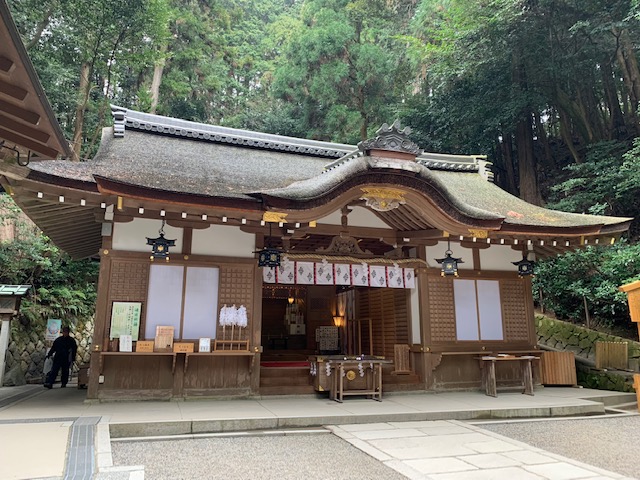三輪山シリーズ#06 「狭井神社(さいじんじゃ)と薬井戸(くすりいど)」
Do you know about Japanese shrines? Sai shrine is one of the sub-shrines of Omiwa shrine, which is one of the oldest shrines in Japan. At 4T-AMKY, Teachers and Students write about Japanese culture, food, history, many spots to visit, and other stuff. Enjoy reading and knowing about deeper Japanese culture!
Mount Miwa#06 ‐Sai shrine and Kusuri-ido(medicine well ).
Sai shrine
When you visit Omiwa shrine* and worship at the Haiden (the worship hall), I highly recommend you also visit the Sai shrine, one of the sub-shrines of Omiwa shrine, which is about 5 minutes on foot from the Haiden.

Simply pass the Kitoden (a ceremony hall) on your left,

and follow a small path called the Kusuri-michi (medicine path) up the side of Mt. Miwa until you reach the Sai shrine.

Ara-mitama* (wild soul of the deity (Kami*) of Omiwa shrine) is worshiped in the Sai shrine. It is Kami of medicine and also Kami of healing of illness.

Medical Herbs Festival
Hanashizume-no-matsuri (Medical Herbs Festival), which is also called Kusuri-matsuri takes place on April 18th every year at the Omiwa and Sai shrines. At this festival the prevention of disease and promotion of good health are celebrated and prayed for.
According to the Taiho Code established in 701, it is specified that the Medical Herbs Festival must take place at Omiwa shrine and Sai shrine every year. It means that the festivals have been celebrated at least for more than 1300 years.(Reference: Hanashizume-no-matsuri in 2022 issued by Omiwa shrine.)

Kusuri-ido (medicine well)
There is an ancient well called Kusuri-ido(medicine well) located to back-left of the main building of the Sai shrine. The well water is a natural spring from the sacred mount Miwa. It is said that drinking it heals all sickness.
The well water is called Goko-zui (water of Kami) or Kusuri-mizu (water of medicine).
Worshippers can drink the well water at the Kusuri-ido. You are welcome to bring empty bottles to fill up at the well and take back to your home. You can also buy bottles of the water at the shrine office.
Whenever I visit the kusuri-ido, I see people constantly taking water from the well.

Tradition
Nara prefecture is famous for drugs for household delivery*, which is called oki-gusuri. Some drug companies visit and get the well water when they start to manufacture drugs. In the same way some food companies visit and get the well water when they start to manufacture Somen (Japanese thin wheat noodles). Miwa area is famous for somen called miwa-somen. Calligraphers and painters also visit and get this well water for their works. It is especially important to collect water from the well when a family member becomes ill. No wonder there are always so many people at kusuri-ido!
This is a tradition that has continued since ancient times, people such as calligraphers and painters, as well as the sick, visit here wishing to receive the power of the Kami of Miwa for their works.

Note:
*Kami: Kami refers to a deity or deities of Shinto.
*Ara-mitama : In the Shinto teachings, it is considered that there are two aspects of a deity soul known as Ara-mitama (Deity’s wild soul)and Nigi-mitama(Deity’s peaceful soul).
Ara-mitama is energy that leads people to happiness. When it cuts off evils it is often rough and violent so it is called wild soul.
*Drugs for household delivery: Drugs stored at home. These drugs sored at home and distributed by household distributors of drug companies and people pay only when they use them. This system of selling drugs has been continued since Edo era.
*Omiwa shrine is located in Miwa, Sakurai city, Nara prefecture.
三輪山シリーズ#06「狭井神社(さいじんじゃ)と薬井戸」
狭井神社
大神神社(おおみわじんじゃ)を訪れて拝殿でお詣りをしたら、ぜひ狭井神社にも立ち寄られてください。祈祷殿を左手に通り過ぎて、くすり道を5分ほど歩いていくと、大神神社の摂社である狭井神社にたどり着きます。
狭井神社には大神神社の大神の荒魂(あらみたま)*が祀られています。医薬の神様であり、また、病気平癒の神様です。
くすり祭
4月18日には毎年大神神社と狭井神社で「鎮花祭(はなしずめのまつり)」が行われています。「くすり祭り」とも呼ばれます。国内の疫病鎮圧、健康増進が祈願されます。
『大宝令』(701年)の中で、「大神神社と狭井神社において鎮花祭を毎年必ず行う」ことが規定されているので、その時代から今日まで、少なくとも1300年以上にわったって続けられているお祭りです。(大神神社発行「令和4年鎮花祭」記事参照)
薬井戸(くすりいど)
狭井神社の左奥には、「薬井戸」と呼ばれる井戸があります。御神体三輪山のお水が湧き出ています。万病に効くと言われています。
お水は、御神水(ごこうずい)とか薬水(くすりみず)と呼ばれます。
コップが用意されていて、参拝者はその場でお水を飲むことができます。空のペットボトルを持ってくれば持ち帰ることもできます。社務所でも販売しています。
薬井戸は、お水を汲みに来る人たちで、いつも人が絶えません。
奈良は配置薬(置き薬)として有名ですが、薬の作り初めにはこの神水をもらいに来たりします。同じように、三輪そうめんの仕込みの時も。また、書道家や絵描きなどもこの水を汲みに来ますが、何と言っても、家族に病人が出た時は、こぞってこの井戸水をもらいに来ます。そのようなわけでいつも人が多いのです。
昔から、病人はもちろん、書家も絵描きも自分の書や絵に三輪の神様の力をいただきたいとの思いで昔から続く伝統です。
*神道において、神様は二つの側面を持ち、優しく平和的な側面を和魂(にぎみたま)、荒々しい側面を荒魂(あらみたま)といいます。荒魂は現れ御霊とも呼ばれ、人を幸に導くエネルギーであり、邪を切る時に荒々しい形をとることが多いのでこの名があります。
Aki. S.
Editor: Stuart Cauley.
監修及び写真提供:大神神社東京分祠代表 根本幸夫先生






